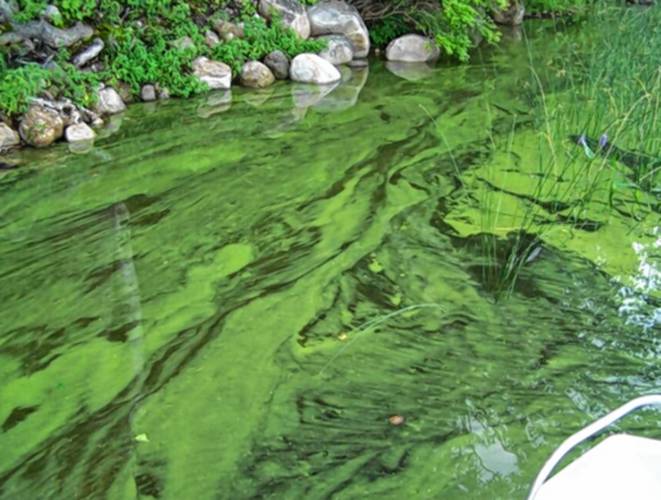‘A huge relief’: A treatment on Lake Kanasatka successfully eliminates cyanobacteria blooms

There are about 12 different species of the bacteria across New Hampshire, all of which can have different presentations. Some look like an oil slick on top of the water, but the typical presentation is a blue-green splotch. NEW HAMPSHIRE DEPARTMENT OF ENVIRONMENTAL SERVICES—Courtesy
| Published: 08-09-2024 10:53 AM |
For nearly four years, cyanobacteria blooms continued to appear on the surface of Lake Kanasatka in Moultonborough, which flows into Lake Winnipesaukee. They disrupted a local summer camp, as well as resident activities. But thanks to the work of lake residents and state officials, a treatment this spring has left Lake Kanasatka’s waters crystal clear.
Cyanobacteria are a type of microorganism that naturally occur in bodies of water, and form blooms when they multiply on the water’s surface. Some blooms can pose a health risk to humans and animals because they produce cyanotoxins. The toxins cause a range of allergy or flu-like reactions, and in rare cases, can be fatal.
According to the New Hampshire Department of Environmental Services, cyanobacteria blooms are becoming more common due to warming water temperatures and shifting rain patterns.
On Lake Kanasatka, a cyanobacteria report in 2020 began one of the most severe cases documented in state history.
David Neils, an aquatic biologist with the state’s environmental services department, said the lake saw especially poor conditions in 2023, when a cyanobacteria bloom lasted over 120 days. A typical bloom lasts about a few weeks.
Andrea LaMoreaux, President of NH Lakes, said the cyanobacteria blooms were fueled by a large deposit of phosphorus deep at the bottom of the lake, caused by nutrient pollution decades ago.
“Nutrients sound like a good thing, but too many nutrients in our lakes cause too much plant growth, too much algae growth, and too much cyanobacteria growth,” she said.
Normally that phosphorus might be trapped on the bottom of the lake, but low oxygen levels allowed it to dissolve into the water – and feed the cyanobacteria.
Article continues after...
Yesterday's Most Read Articles
 ‘Pillar of the community’: The Fenton family gives back after receiving resounding support over the years
‘Pillar of the community’: The Fenton family gives back after receiving resounding support over the years
 Repealed car inspections and Ayotte’s veto threat: What to look for in the State House this week
Repealed car inspections and Ayotte’s veto threat: What to look for in the State House this week
 Webster seized and sold his house for back taxes. Now the town has agreed to pay him $38,000
Webster seized and sold his house for back taxes. Now the town has agreed to pay him $38,000
 City considers proposal for sanctioned homeless encampment
City considers proposal for sanctioned homeless encampment
 Arts Alley slated to make its debut in August
Arts Alley slated to make its debut in August
 Hillclimbs, nightlife and cruising: Enthusiasts flock to 102nd Laconia Motorcycle Week
Hillclimbs, nightlife and cruising: Enthusiasts flock to 102nd Laconia Motorcycle Week
The community quickly took action to address the blooms. The Lake Kanasatka Watershed Association raised money with the town to fund a lake management plan. That plan and their advocacy helped persuade state officials to fund what’s known as an alum treatment this spring.
The treatment works by binding the phosphorus to the lake bottom with aluminum sulfate, cutting off the cyanobacteria’s food source.
“They put aluminum sulfate into the lake…to sort of seal the sediment to keep that phosphorus in there,” LaMoreaux said.
Only two other lakes in the state have received a similar treatment, which cost the state $500,000. The funds came from a cyanobacteria mitigation fund created by the legislature in 2023.
So far, the treatment appears to have worked. Eric Carlson is a local summer camp director, and said its success was “a huge relief.”
“The kids are loving the lake,” he said. “We're not waking up each day, concerned about whether or not there'll be a bloom.”
The treatment is expected to last between ten and fifteen years, but property owners will need to prevent new pollution to ensure its longevity. LaMoreaux said there are many steps property owners can take, like avoiding fertilizer use and adding plants like bushes or trees to their shoreline.
Watershed association members like Rob Baker regularly volunteer on properties around the lake, to work on projects to prevent pollution.
He’s 74 years old, and built his house there in 1985. His granddaughters visit the lake each summer, and it’s become an important place for his family.
“Kanasatka is a very small lake, it's relatively quiet and peaceful,” he said. “I couldn't stand to see it go green for years on end.”







 Granite Geek: The circle of life is painful when watching the species-gets-killed part
Granite Geek: The circle of life is painful when watching the species-gets-killed part Concord’s two Rite Aid stores shutting soon
Concord’s two Rite Aid stores shutting soon
